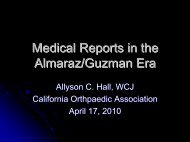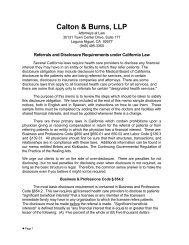Enhancing Your Practice's Revenue - California Orthopaedic ...
Enhancing Your Practice's Revenue - California Orthopaedic ...
Enhancing Your Practice's Revenue - California Orthopaedic ...
- No tags were found...
Create successful ePaper yourself
Turn your PDF publications into a flip-book with our unique Google optimized e-Paper software.
Section 3The HospitalChapter 7On-Call CompensationBy Aleksandar Curcin, M.D., M.B.A.Why Has On-call CompensationBecome an Issue?From the perspective of physicians trained in the “oldguard” (and I am a proud card-carrying member of thatgroup), taking call was simply a rite of passage. We allhad that responsibility ingrained in us from the beginningof our third year in medical school, when we started ourclinical rotations. Quite frankly in that context taking call,initially at least, was sort of fun and exciting. For the mostpart we were young and energetic and accustomed to longhours and sleep deprivation. We never knew what nextfascinating case or medical problem we would encounter.At times being on-call was downright entertaining asevidenced by the post-call stories of some of the more“colorful” patients that may have paraded through theEmergency Department (ED). In summary, being on-callin the context of medical school and residency was akin tobeing part of a fraternity or sorority.Once we completed our graduate medical training(GMT), call took on an entirely different meaning formany of us. In addition to “helping out” our partners,taking call meant a more rapid exposure to the communityand expansion of our referral base. Basically, taking callmeant patients came to us that we didn’t necessarily haveto recruit. In many practices the more a physician took call,the more quickly his or her practice and income grew. Severalparameters have changed, however, that have broughtabout substantial resistance and outright dislike for whatthe “old guard” considered part of “being a doctor.” Thechanges that occurred can be classified into three categories:financial, regulatory, and social.Financial: In 1992, the government implemented the ResourceBased Relative Value Scale (RBRVS) system, whichdrastically changed the way physicians were reimbursed.The downward spiral in physician payments seems to intensifywith each passing year. It is easy to understand froma purely dollars and cents basis the reluctance of currentdayphysicians to take call under these circumstances. Whatour predecessors collected for getting out of bed at 2:00 amand going to the ED to set a fracture is a far cry from whattoday’s physician receives on a current dollar value basis.Furthermore, it is an unfortunate reality now that manyof our society’s uninsured patients utilize the EmergencyDepartment as their resource for primary care. Once thatpatient is seen by the orthopaedic surgeon in the emergencyroom, despite their ability or inability to pay for their medicalcare, their follow-up care and associated cost (at least toan extent) becomes our responsibility as well.Regulatory: In 2003, the Accreditation Council of GraduateMedical Education (ACGME) made significant changesin the medical postgraduate training policies, including the80 duty hours per week regulation. This rule, while wellintended, set into motion a cascade of behavior changes.One of those included the ability for young doctors tosay, “No.” In the “old guard” regime, refusing to take callor stay late to see one more case was essentially taboo andbordered on career suicide. With the new regulations, however,a new breed of doctor began to emerge, a doctor whosuddenly answered to a new authority which empoweredhim/her to say, “No” to a variety of things, including automaticallyaccepting the responsibility of taking call. [Note:in fact, another significant regulatory change had alreadytaken place in 1986 with the enactment of the EmergencyMedical Treatment and Active Labor Act (EMTALA).A detailed discussion of this statute and its updates andrevisions is beyond the scope of this chapter; however, it isrelevant to note that this law places a substantial burden ofresponsibility on any physician participating in a hospitalon-call schedule. See www.aaos.org.]Social: From a social perspective, taking call brings withit the unpredictability of managing personal and familyschedules. The fabric and composition of the medicalworkforce has changed substantially over the past twentyfiveyears. Along with that change has come a greater expectationfor a physician’s private time to be protected. For the“old guard,” missing a soccer game or dance performancewas a badge of toughness; for today’s breed of doctor,doing that on a routine basis is simply unacceptable. Asa result, taking part in the on-call schedule becomes evenmore onerous. Lastly, and this too is a social phenomenon,society in general (and patients in particular) have becomeincreasingly litigious. This also impacts physicians’ willingnessto take call. Our generally litigious society – combinedwith the reality that hospitals often have limited resourcesand some physicians have a limited sense of personal26 © 2011 American Academy of <strong>Orthopaedic</strong> Surgeons
















